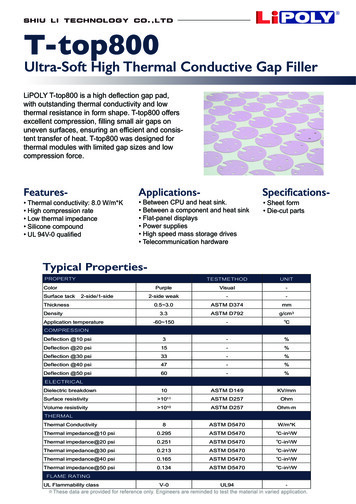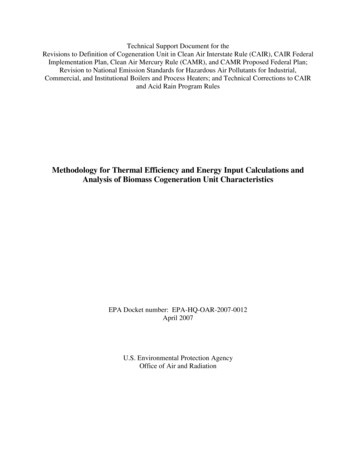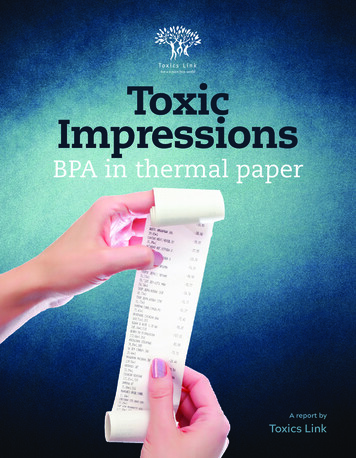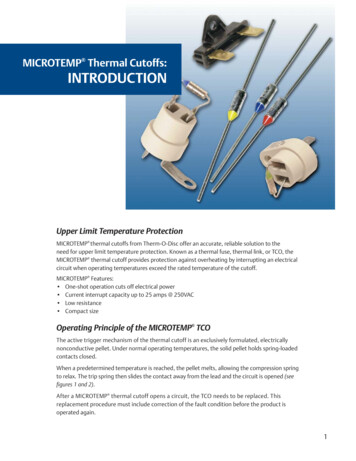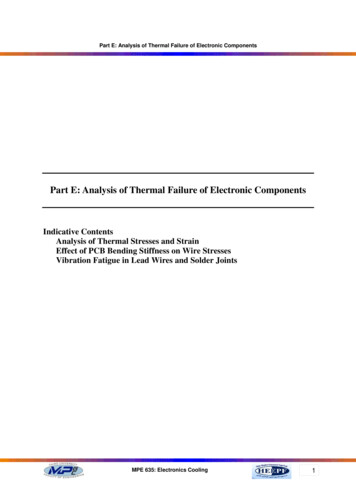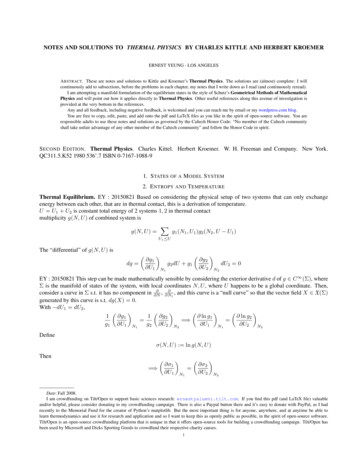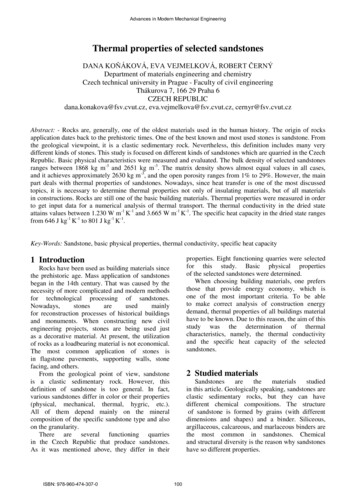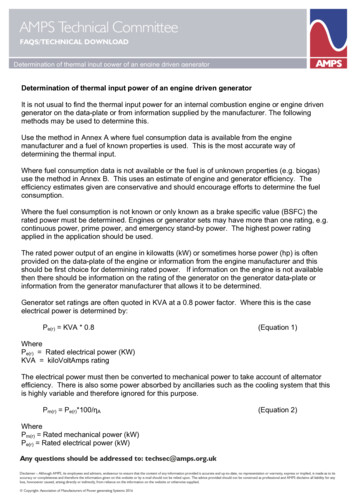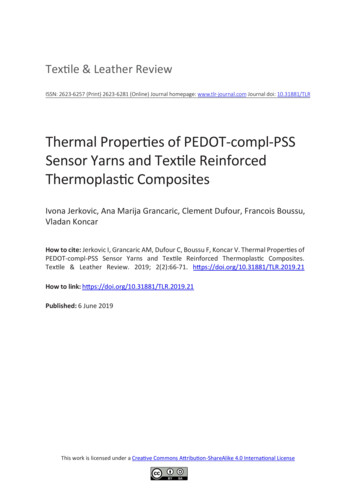
Transcription
Tex le & Leather ReviewISSN: 2623-6257 (Print) 2623-6281 (Online) Journal homepage: www.tlr-journal.com Journal doi: 10.31881/TLRThermal Proper es of PEDOT-compl-PSSSensor Yarns and Tex le ReinforcedThermoplas c CompositesIvona Jerkovic, Ana Marija Grancaric, Clement Dufour, Francois Boussu,Vladan KoncarHow to cite: Jerkovic I, Grancaric AM, Dufour C, Boussu F, Koncar V. Thermal Proper es ofPEDOT-compl-PSS Sensor Yarns and Tex le Reinforced Thermoplas c Composites.Tex le & Leather Review. 2019; 2(2):66-71. h ps://doi.org/10.31881/TLR.2019.21How to link: h ps://doi.org/10.31881/TLR.2019.21Published: 6 June 2019This work is licensed under a Crea ve Commons A ribu on-ShareAlike 4.0 Interna onal License
JERKOVIĆ I et al, Thermal Properties of PEDOT-compl-PSS Sensor Yarns. TEXT LEATH REV 2 (2) 2019 66-71.Thermal Properties of PEDOT-compl-PSS Sensor Yarns andTextile Reinforced Thermoplastic CompositesIvona JERKOVIĆ1*, Ana Marija GRANCARIĆ1, Clément DUFOUR2, François BOUSSU2,Vladan KONČAR21University of Zagreb, Faculty of Textile Technology, Department of Textile Chemistry and Ecology, Zagreb, CroatiaEcole Nationale Supérieure des Arts et Industrie Textiles, Gemtex, Roubaix, France*ivona.jerkovic@ttf.hr2Original scientific articleUDC 687.017.56DOI: 10.31881/TLR.2019.21Received 19 December 2018; Accepted 18 February 2019; Published Online 20 February 2019; Published 6 June 2019ABSTRACTSmart textile structures such as sensor yarns provide real possibility for in situ structural health monitoringof textile reinforced thermoplastic composites. In this work thermal properties of E-glass/polypropylene (GF/PP) and E-glass/poly(N,N’-hexamethylene adipamide) (GF/PA66) sensor yarns based on conductive polymercomplex nzenesulfonic acid) (PEDOT-compl-PSS) and relatedcomposites were studied. Thermogravimetric analysis (TGA), microscale combustion calorimetry (MCC) andlimiting oxygen index (LOI) methods were used to detect thermal behaviour of these structures and effect ofcoatings applied. According to TGA, GF/PP sensor yarn started to decompose at higher temperature, 345 C,and showed higher pyrolysis residue, 28 %, compared to GF/PA66 sensor yarn that started to decompose at316 C and had lower pyrolysis residue, 23 % . The MCC showed that Heat Release Rate peaks of GF/PP sensoryarn, 341 W/g, and GF/PA66 sensor yarn, 348 W/g, occurred at similar Heat Release Temperature, 430 C.The additional peak, 51 W/g, was detected for GF/PP sensor yarn at 493 C. Finally, LOI 22 and LOI 23 weredetected only for GF/PP and GF/PA66 composites with integrated sensor yarns.KEYWORDSSmart textile, PEDOT-compl-PSS, textile sensors, textile reinforced composites, thermal propertiesINTRODUCTIONSmart textile structures can be made by coating or treating textile yarns, filaments, or fabrics with conductive and semi conductive polymers. They provide real possibility for in situ structural health monitoring oftextile reinforced composites [1-2]. Commercially very useful conductive polymer complex poly[3,4 esulfonic acid) (PEDOT-compl-PSS) produce transparent coatings with high mechanical flexibility, excellent thermal stability and ease of synthesis [3]. Textile reinforcedthermoplastic composites can be used for transportation applications due to their high fracture toughness,recycling possibility, damage tolerance, etc. [3-5] Polypropylene (PP) and poly(N,N’-hexamethylene adipamide) (PA66) as polymer matrices have been widely taken for automobile applications [6]. Glass fibres aresuitable reinforcements in composites and are characterised by hardness, resistance to chemical agents,insulating properties, etc. [7] Textile materials are very flexible in all directions and sensors used should be66 www.tlr-journal.com
JERKOVIĆ I et al, Thermal Properties of PEDOT-compl-PSS Sensor Yarns. TEXT LEATH REV 2 (2) 2019 66-71.able to support mechanical deformations [8]. In this work thermal properties of sensor yarns and composites were studied to detect thermal behaviour of these structures and effect of coatings applied.EXPERIMENTALMaterials and MethodsE-glass/polypropylene (GF/PP) and E-glass/poly(N,N’-hexamethylene adipamide) (GF/PA66) commingledyarns by PD Fiberglass group (Glasseiden GmbH, Oschatz, Germany) were used for sensor yarns manufacturing. Fineness of GF/PP is 842 tex (GF/PP mass content of 71%:29%), while fineness of GF/PA66 yarn is957 tex (GF/PA66 mass content of 65%:35%) [2-3]. A novel piece of laboratory equipment, aluminum rollto roll device and plexiglass bath, was taken to ensure effective and equally distributed coating onto yarnwithout destruction of textile properties. During the sensor yarns manufacture, two layers of conductivecoating based on polymer complex PEDOT-compl-PSS were applied. The aqueous dispersion of copolymersof acrylic esters (synthetic latex) was used also as protective coating to join yarn filaments together andprotect sensor yarns from abrasion [3].Finally, sensor yarns based on PEDOT-compl-PSS were integrated during weaving 2D fabric (thickness 2.660x 10-3 m), 4-end satin, in weft direction, using computer controlled hand weaving loom (ARM, Biglen, Switzerland); GF/PP fabric (warp density, 4 ends/cm and weft density, 6 ends/cm) or GF/PA66 fabric (warp density,5 ends/cm and weft density, 6 ends/cm). Three-layered textile preforms with integrated sensor yarns wereconsolidated at the Dolouets heating press (Soustons, France) under the strict conditions (Table 1) to developcomposites with integrated sensor yarns.Table 1. Consolidation conditions of 2D textile preforms with integrated sensor yarnsConditionsThree-layered 2D fabric for textile preform preparationGF/PPGF/PA66Sensor yarnsGF/PPGF/PA66Temperature, T ( C)185230Pressure, P (MPa)4-54-5Time of cooling at 100 C (min)2-33-4Thermogravimetric analysis (TGA), microscale combustion calorimetry (MCC) and limiting oxygen index(LOI) methods (average of three samples per each structure) were used for thermal properties determination of dry films (conductive and protective coatings), non-coated and sensor yarns, and textile reinforced2D thermoplastic composites with integrated sensor yarns.TGA (5 mg test samples) was carried out (TGA Q50, TA Instruments, New Castle, DE, USA) in nitrogen atmosphere under the following conditions: flow rate of 50 mL/min and heating rate of 10 C/min over the temper ature range from 50 C to 600 C to achieve data of coating effects on the treated yarns, pyrolysis residuesand the temperature of sample decompositions.MCC tests were performed using microscale combustion calorimeter, model MCC-2 (Govmark, Farmingdale,NY, USA) according to the ASTM D 7309 standard. In the MCC test, 5 mg test samples were heated from 75to 600 C at the heating rate of 1 C/s, in an inert gas stream (nitrogen, 1.33 ml/s).LOI measurements were performed on the LOI instrument (Dynisco, Franklin, MA, USA) according to theISO 4589-1:1996 and the ISO 4589-2:1996 standards to obtain flammability data of textile reinforced 2Dthermoplastic composites with integrated sensor yarns.www.tlr-journal.com 67
JERKOVIĆ I et al, Thermal Properties of PEDOT-compl-PSS Sensor Yarns. TEXT LEATH REV 2 (2) 2019 66-71.RESULTS AND DISCUSSIONThermogravimetrical data of dry films (conductive and protective coatings), non-coated and sensor yarnsare shown in Table 2 and in Figure 1.Table 2. Thermogravimetric data of dry films, non-coated and sensor yarnsInitial DecompositionTemperature,Tign( C)Final DecompositionTemperatureTendset( C)Yield of PyrolysisResidue,Yp(%)Sample DescriptionSample LabelConductive Dry Film8 % PEDOT-compl-PSSFET- LApp96100DF2334807Protective Dry FilmLapp96100DF3284474Non-coated YarnGF/PP34444772Non-coated YarnGF/PA6636548267Sensor YarnGF/PP-Sy0834548328Sensor YarnGF/PA66-Sy0831647023Conductive dry film, 8 % PEDOT-compl-PSS FET LApp96100DF, started its degradation earlier than protective dry film, LApp96100DF, while its final decomposition temperature was higher. Conductive dry filmshowed also higher pyrolysis residue. GF/PP yarn started to decompose first, and its degradation endedearlier compared to GF/PA66 yarn.Figure 1. TGA curves of dry films, non-coated and sensor yarnsThis can be explained with a lower decomposition “phase” of PP compared to the PA66 thermoplasticpolymer. GF/PP sensor yarn started to decompose at higher temperature than GF/PA66 sensor yarn. Thecause could be greater coating thickness of GF/PA66 sensor yarn that showed also lower pyrolysis residue.The MCC data of dry films (conductive and protective coating), non-coated and sensor yarns are presentedin Table 3. The results of Heat Release Rate, HRR (W/g), in correlation with the maximum temperature, Tmax( C) are shown in Figure 2.68 www.tlr-journal.com
JERKOVIĆ I et al, Thermal Properties of PEDOT-compl-PSS Sensor Yarns. TEXT LEATH REV 2 (2) 2019 66-71.Table 3. MCC data of dry films, non-coated and sensor HeatRelease,Qmax(W/G)HeatReleaseTemperature,Tmax( C)Yield ofPyrolysisResidue,Yp(%)Sample DescriptionSample LabelConductive Dry Film8% PEDOT-compl-PSS FET LApp96100DF3583624278Protective Dry FilmLApp96100DF4764834302Non-coated YarnGF/PP30230348573Non-coated YarnGF/PA6623321644761Sensor YarnGF/PP-Sy08337341/51434/49325Sensor YarnGF/PA66-Sy0834434843021Conductive and protective dry films provided high HRR peaks (362 W/g and 483 W/g) and low Yp (8 % and2 %). Non-coated yarns, GF/PP and GF/PA66, showed lower HRR peaks (303 W/g and 216 W/g) and higherYp (73 % and 61 %). The HRR peaks of GF/PP (341 W/g) and GF/PA66 (348 W/g) sensor yarns occurred atsimilar Heat Release Temperature, Tmax ( 430 C). The additional peak (51 W/g) was detected for GF/PPsensor yarn at 493 C. Finally, MCC pyrolysis residues were coherent with the obtained TGA residue values.Figure 2. MCC curves of dry films, non-coated and sensor yarnsLOI measurements of textile reinforced 2D thermoplastic composites with integrated sensor yarns arepresented in Table 4.Table 4. LOI of textile reinforced 2D thermoplastic composites with integrated sensor p-GF/PA66-Sy0823723Sample DescriptionSample LabelGF/PP Composite with Integrated GF/PP Sensor YarnGF/PA66 Composite with Integrated GF/PA66 Sensor Yarnwww.tlr-journal.com 69
JERKOVIĆ I et al, Thermal Properties of PEDOT-compl-PSS Sensor Yarns. TEXT LEATH REV 2 (2) 2019 66-71.During heating PP or PA66 polymer softened, melt and dripped. GF/PP composite with integrated GF/PPsensor yarn showed LOI 22 . PP burns rapidly with a smoke-free flame, with no char residue left and canaid in fire propagation. On the other hand, GF fibres, as inorganic material, do not burn or support combustion, but start to deform when the temperature reaches 500 C or above [9]. GF/PA66 composite with integrated GF/PA66 sensor yarn showed LOI 23 due to different thermal consolidation conditions of 2D textilepreform prepared.CONCLUSIONGF/PP sensor yarn started to decompose at higher temperature than GF/PA66 sensor yarn due to greatercoating thickness applied onto the GF/PA66 commingled yarn during sensor yarn manufacture. MCC pyrolysis residues were coherent with the obtained TGA residues. Higher HRR peaks of sensor yarns occurred atslightly lower temperature compared to non-coated yarns. GF/PP and GF/PA66 composites with integratedPEDOT-compl-PSS sensor yarns showed low LOI and fire.AcknowledgementsThe paper is a part of the EU project “MAPICC 3D” results within the call NMP-FP7- 2010-3.4-1, numberedwith 263159 entitled: One-shot Manufacturing on large scale of 3D up graded panels and stiffeners for lightweight thermoplastic textile composite structures. The authors would like to thank the European Commission for funding of the project.REFERENCES[1]Grancarić AM, Jerković I, Končar V, Cochrane C, Kelly FM, Soulat D et al. Conductive Polymers for SmartTextile Applications. Journal of Industrial Textiles [Internet]. 2017;48(3):612-642. Available from: 83717699368 doi: 10.1177/1528083717699368[2]Grancarić AM, Jerković I, Leskovac M, Dufour C, Boussu F, Končar V. Surface Free Energy of Sensor Yarnsand Textile Reinforced Thermoplastic Composites. In: Simoncic B, Gorjanc M, editors. Proceedings 16thWorld Textile Conference AUTEX; 8-10 June 2016; Ljubljana, Slovenia. Ljubljana: University of Ljubljana,Faculty of Sciences and Engineering, Department of Textiles, Graphic Arts and Design; 2016. p. 6-111-6-11-6.[3]Jerković I, Končar V, Grancarić AM. New Textile Sensors for In Situ Structural Health Monitoring of TextileReinforced Thermoplastic Composites Based on the Conductive Poly(3, 4ethylenedioxythiophene)poly(Styrene Sulfonate) Polymer Complex. Sensors [Internet]. 2017;17(10):2297. Available from: https://www.ncbi.nlm.nih.gov/pubmed/28994733 doi: 10.3390/s17102297[4]Liu D, Ding J, Fan X, Lin X, Zhu Y. Non-Isothermal Forming of Glass Fiber/Polypropylene CommingledYarn Fabric Composites. Materials & Design. 2014;57:608-615. Available from: 83717699368 doi: 10.1016/j.matdes.2014.01.027[5]Teixeira D, Giovanela M, Gonella LB, Crespo JS. Influence of Flow Restriction on the Microstructureand Mechanical Properties of Long Glass Fiber-Reinforced Polyamide 6.6 Composites for AutomotiveApplications. Materials & Design. 2013;47:287-294. Available from: S0261306912008515 doi: 10.1016/j.matdes.2012.12.030[6]Friedrich K, Almajid A. Manufacturing Aspects of Advanced Polymer Composites for AutomotiveApplications. Applied Composite Materials. 2013;20(2):107-128. Available from: 12-9258-770 www.tlr-journal.com
JERKOVIĆ I et al, Thermal Properties of PEDOT-compl-PSS Sensor Yarns. TEXT LEATH REV 2 (2) 2019 66-71.[7]Zănoagă M, Tanasă F. Complex Textile Structures as Reinforcement for Advanced Composite Materials.Proceedings International Conference of Scientific Paper AFASES; 22-24 May 2014; Brasov, Romania;2014. p. 1-7.[8]Jerković I, Dufour C, Legrand X, Tao X, Boussu F, Grancarić AM et al. E- Glass/Polypropylene Sensor YarnsDeveloped by Roll to Roll Coating Procedure. In: Lahlou M, Koncar V. Proceedings 5th ITMC InternationalConference 2015; 4-6 November; Casablanca & Marrakesh, Morocco; 2015. p. 68-74.[9]Kandola BK, Toqueer-Ul-Haq R. The Effect of Fibre Content on the Thermal and Fire Performance ofPolypropylene–Glass composites. Fire and Materials. 2012;3688):603-613.www.tlr-journal.com 71
TGA (5 mg test samples) was carried out (TGA Q50, TA Instruments, New Castle, DE, USA) in nitrogen atmos- phere under the following conditions: flow rate of 50 mL/min and heating rate of 10 C/min over the temper- ature range from 50 C to 600 C to achieve data of coating effects on the treated yarns, pyrolysis residues and the temperature o.

